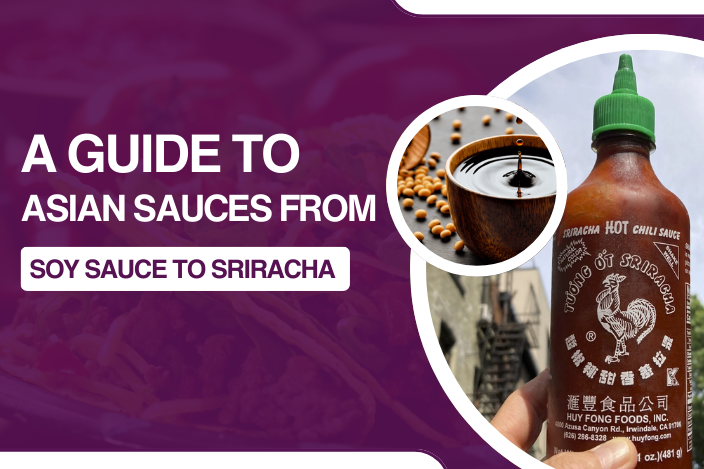Asian cuisines are celebrated worldwide for their bold and vibrant flavours, many of which owe their depth to an array of iconic sauces. From the umami-packed soy sauce to the fiery heat of Sriracha, each condiment has its unique taste, history, and culinary purpose. This guide will take you on a flavourful journey through the most popular Asian sauces, how they’re made, their culinary uses, and tips for incorporating them into your cooking.
If you're exploring Asian flavours for the first time, check out 10 Must-Try Asian Food Products You Can’t Live Without to pair your dishes perfectly!
Soy Sauce: The Umami Powerhouse
What is Soy Sauce?
Soy sauce is a salty, umami-rich liquid from fermented soybeans, wheat, water, and salt. Originating in ancient China over 2,000 years ago, it has become a staple across Asian cuisines and beyond.
Types of Soy Sauce
- Light Soy Sauce: A thinner, saltier version often used for seasoning.
- Dark Soy Sauce: Thicker, with a slightly sweeter flavour, perfect for marinades and adding colour to dishes.
- Tamari: A gluten-free variant with a mellow, less salty profile.
How to Use Soy Sauce
- In stir-fries: Adds a savoury depth to vegetables, meats, and noodles.
- For dipping: A perfect pairing with dumplings and sushi.
- In marinades: Enhances the flavour of proteins like chicken, beef, or tofu.
Looking for high-quality ingredients to experiment with? Discover Vietnamese food suppliers in the UK and elevate your culinary creations!
Fish Sauce: The Essence of Southeast Asia
What is Fish Sauce?
Fish sauce is a pungent, amber-coloured liquid made from fermented fish and salt. Popular in Southeast Asian cuisines, it adds a salty, umami kick to dishes.
Famous Varieties
- Vietnamese Nước Mắm: A premium fish sauce with a balanced flavour.
- Thai Nam Pla: Slightly stronger and saltier, commonly used in Thai dishes.
How to Use Fish Sauce
- In soups: Essential for creating authentic pho or tom yum.
- As a dressing: Combines beautifully with lime juice and sugar for a tangy salad dressing.
- In dipping sauces: Blend well with chilli, garlic, and lime for a zesty condiment.
Hoisin Sauce: Sweet and Savoury
What is Hoisin Sauce?
Hoisin sauce is a thick, dark sauce with a sweet and tangy profile, made from soybeans, sugar, vinegar, and various spices. Often referred to as “Chinese barbecue sauce,” it adds a unique depth to dishes.
Culinary Uses of Hoisin Sauce
- As a glaze: Ideal for roasted or grilled meats.
- In wraps: A key ingredient in Peking duck and moo shu pork.
- As a dipping sauce: it is perfect for spring rolls and fried appetisers.
Find more Asian cooking essentials at Tiger Tiger Foods for all your culinary needs.
Oyster Sauce: The Savoury Enhancer
What is Oyster Sauce?
Oyster sauce is a thick, dark condiment made by reducing oyster extracts and blending them with sugar and soy sauce. Its rich, savoury flavour makes it a favourite in Cantonese cuisine.
How to Use Oyster Sauce
- In stir-fried dishes: Elevates vegetables, noodles, and meats with its umami punch.
- As a marinade: Adds complexity to beef or chicken marinades.
- In fried rice: A small drizzle can transform the dish.
For a variety of quality Asian sauces and more, check out JK Foods.
Sriracha: The Fiery Favourite
What is Sriracha?
Originating in Thailand, Sriracha is a bright red chilli sauce made from chilli peppers, vinegar, garlic, sugar, and salt. It has gained global fame for its spicy, tangy kick.
Uses for Sriracha
- As a condiment: Drizzle over eggs, burgers, or sandwiches.
- In sauces: Mix with mayonnaise for a creamy, spicy dip.
- In marinades: Add heat and depth to grilled meats or tofu.
Tips for Cooking with Asian Sauces
- Start small: Many Asian sauces are concentrated in flavour; a little goes a long way.
- Combine sauces: Mix soy sauce with oyster sauce or fish sauce for complex flavours.
- Store properly: Keep sauces in cool, dark places or refrigerate after opening to preserve freshness.
Frequently Asked Questions
Why is soy sauce so salty?
Soy sauce is traditionally made with a high salt content to aid in preservation and fermentation.
Can I substitute hoisin sauce for oyster sauce?
While both are savoury, they have different flavour profiles. Hoisin is sweeter, so adjust other ingredients if substituting.
What makes the fish sauce so pungent?
The fermentation of fish creates a strong aroma, but its taste mellows out when used in cooking.
Is Sriracha gluten-free?
Most Sriracha brands are gluten-free, but it’s best to check the label to be sure.
How long do Asian sauces last after opening?
Most Asian sauces can last several months if stored properly in the refrigerator.
What’s the best way to experiment with Asian sauces?
Add small amounts to stir-fries, marinades, or dressings, and adjust according to taste.
Conclusion
Asian sauces are the heart of many beloved dishes, offering a spectrum of flavours from sweet and savoury to tangy and spicy. By understanding their unique characteristics and uses, you can elevate your cooking and explore a world of culinary possibilities. Ready to get started? Grab your soy sauce, Sriracha, or hoisin, and let the adventure begin!
For more Asian cooking inspiration, visit Tiger Tiger Foods or explore high-quality ingredients at JK Foods.

